Divergent Plate Boundary: Where Earth's Crust Pulls Apart — Passage
The Earth's crust is made up of large, moving pieces called tectonic plates. Where these plates pull apart, they form divergent boundaries. These boundaries create some of the most dramatic landscapes on Earth, including rift valleys on continents and mid-ocean ridges under the sea.
One of the best-known examples is the Mid-Atlantic Ridge, an underwater mountain chain running down the middle of the Atlantic Ocean. Here, two plates move away from each other, allowing magma to rise from below. As the magma cools, it forms new crust, slowly widening the ocean floor. Because of this, the Atlantic Ocean grows about 2.5 centimeters wider each year—a process called seafloor spreading.
On land, divergent boundaries create deep valleys. The Great Rift Valley in East Africa is a massive crack in the Earth’s crust where the African Plate is splitting apart. Over millions of years, this rift could grow so wide that a new ocean may form.
At these boundaries, earthquakes and volcanic eruptions are common as the crust stretches and breaks. The new crust formed at mid-ocean ridges is younger and warmer, making it less dense than older seafloor. This movement helps drive the slow but powerful cycle of plate tectonics, reshaping our planet over time.
By studying divergent boundaries, scientists learn how oceans expand and continents split—key evidence for understanding Earth’s ever-changing surface.
Fun Fact: Iceland is literally splitting in half! The Mid-Atlantic Ridge runs right through the island, pulling it apart at about 2.5 cm per year (the width of a Lego brick). In Thingvellir National Park, you can stand between two continents—one foot on the North American Plate and the other on the Eurasian Plate!
What is the main idea of this passage?
Earthquakes occur only at divergent boundaries.Divergent boundaries create new crust through rift valleys and mid-ocean ridges.The Atlantic Ocean is the oldest ocean on Earth.Tectonic plates never move.What happens at the Mid-Atlantic Ridge?
Two plates collide, forming mountains.Two plates slide past each other, causing earthquakes.Two plates pull apart, forming new oceanic crust.The ocean floor sinks into the mantle.How fast is the Atlantic Ocean widening each year due to seafloor spreading?
1 centimeter2.5 centimeters10 centimeters50 centimetersWhat is the Great Rift Valley an example of?
A convergent boundaryA transform boundaryA continental divergent boundaryA volcanic island chainWhat does the term "seafloor spreading" refer to?
The shrinking of ocean basins over timeThe formation of new crust as plates move apartThe sinking of old crust into the mantleThe collision of two continental platesWhich of the following best describes "magma" in this passage?
Solid rock in Earth’s crustMelted rock beneath Earth’s surfaceA type of fossil found in rift valleysWater trapped in oceanic trenchesWhat might eventually happen to the Great Rift Valley in East Africa?
It will disappear due to erosion.It could form a new ocean if it keeps splitting.It will turn into a high mountain range.It will stop moving in a few years.Why is the new crust at mid-ocean ridges less dense than older seafloor?
Because it is made of lighter mineralsBecause it is warmer and has not yet cooled completelyBecause it contains more fossilsBecause it is made of continental rock













